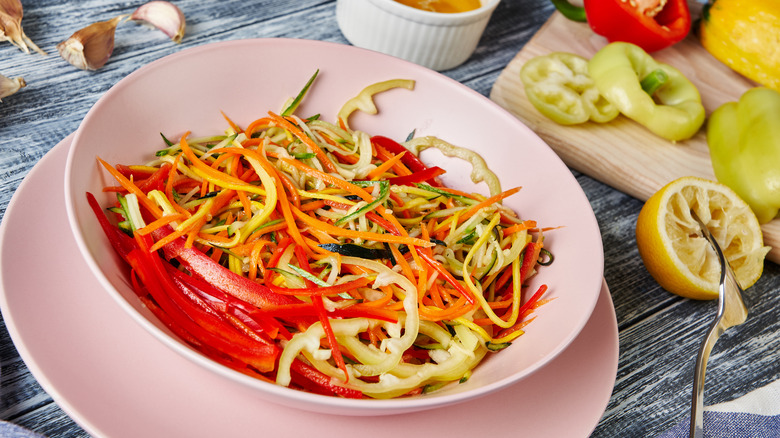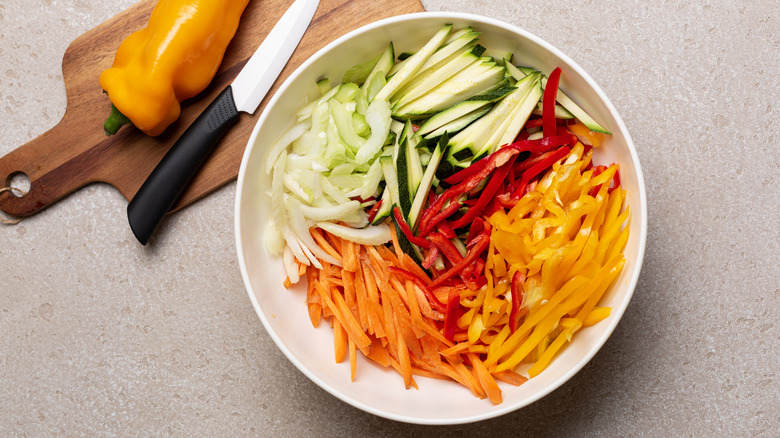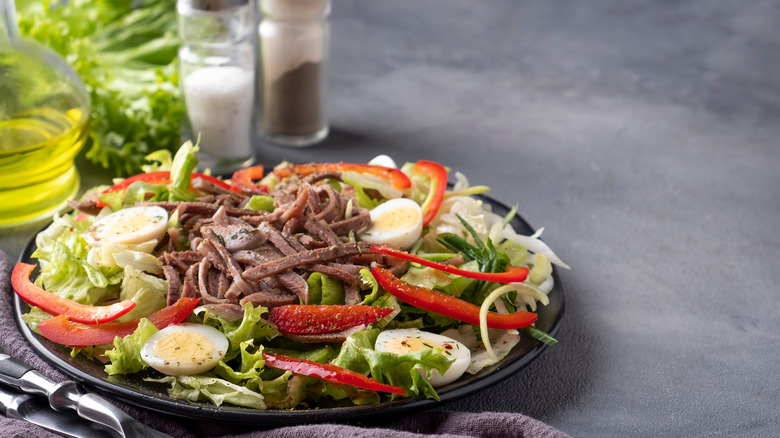The Chinese Veggie Cutting Technique For Beautiful Salads
One of the most popular cutting techniques in Chinese cooking is the julienne cut. Seen often in meals such as stir-fries, spring rolls, or sushi, chefs accomplish this technique by cutting vegetables into thin strips, making sure to keep the size of each veggie uniform by squaring off the edges. The pretty, little end products are also known as veggie matchsticks thanks to their thin and even appearance.
Any sort of vegetable can be julienned, but peppers, zucchini, and carrots are some of the most common choices. While this cutting style may seem complicated at first mention, it's actually one of many basic knife cuts, and it's very simple to accomplish once you've got some practice under your belt. Plus, it has some huge benefits. Thinly sliced veggies like these can really amplify your dish of choice by bringing balance to every bite, with no thick vegetables coming to crowd your spoon and overwhelm your tastebuds. Julienned veggies are also super easy to pick up with a pair of chopsticks, so they're convenient in that way, too.
While any dish could do well with the presence of these thinly sliced veggies, they do especially well in refreshing meals such as bright and beautiful salads. So, if you want to try it for yourself, here's how you can julienne your veggies perfectly at home.
How to prep your veggies using the julienne technique
To perfect the julienne cutting style, also known as a strip cut, you'll need to cut your vegetables into long, thin strips using a sharpened chef's knife and a large cutting board. Peel your vegetables to start, if needed, then cut each of your vegetables into a uniform square. The exact size of this is up to you, but most chefs tend to cut their squares roughly 2–3 inches in length. Once you've made those initial shapes, slice thin sheets off of your veggie segments and stack them. Now, cut these sheets into long, thin strips, each less than ⅛ inch in width, until you have a pile of freshly julienned veggies prepped and ready to go.
Patience is key in this process, as it's difficult to achieve that desirable, thin end product without focus and observation. If you're not a fan of the time-consuming aspect of this process, you can always get some help from kitchen tools like a mandoline or a julienne peeler, which can quickly slice your veggies in half the time.
Now that you've got your veggies prepped, they're ready to be tossed in a bowl with some mixed greens and zesty dressings. These raw veggies will bring a satisfying crunch to your bowl, but you can also elevate other aspects of your salad.
How to beautify your julienne salad
While julienned vegetables make for satisfyingly balanced bites, you can take your salad even further with the help of other rich additions. Thinly cut veggies make for great textures, but light and bright dressings can further elevate the taste and visual appeal of your bowl. Dressings made from light ingredients such as lemon juice and olive oil would do best in jazzing up your leafy greens.
To match the refreshing presence of your raw veggies, you could add in some equally fresh choices — try healing herbs such as rosemary and mint. To bring some starchy goodness into the mix, you could even julienne a potato to make fries and add some salty contrast to your medley of fresh veggies. Lastly, to add further contrast to the lightness here, embolden your salad with a luxurious drizzle of balsamic, or a few rich slices of avocado or boiled eggs.
Learning how to julienne is one knife technique that chefs use not just in the world of Chinese cooking but in kitchens all around the globe. With this skill in your toolbox, any meal can become beautiful and balanced with the simple twist of a knife. Don't shy away from the unknown and get to practicing.


